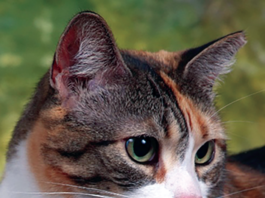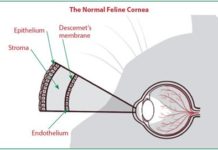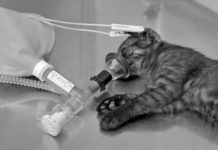The Common Cause of Ear Infections
One common reason for veterinary visits among cats is otitis externa, or inflammation of the external ear canal. Most people believe that that the term otitis externa means an ear infection, but that isnt true. Something has to breech the normal defense mechanism of the ear to trigger the infection, says veterinary dermatologist William H. Miller, Jr., VMD, Medical Director of the Cornell University Hospital for Animals. Once the surface of the ear canal is damaged, bacteria or yeast inside and around the canal can cause an infection. The underlying causes can include tumors, allergies, ticks or fleas, and excessive grooming and ear wax. But by far the most frequent cause in cats, especially kittens, is ear mites.
The Anatomy of the Cornea
The cornea, the clear coating of the eye that admits light, has layers of specialized skin cells, including:
Techniques and Treatments From Stem Cell Therapy to Massage
These are among the treatments that veterinarians increasingly use to improve cats well-being:
A Cat on an Underwater Treadmill?
The cats hip problem was so painful that he required a femoral head osteotomy, the surgical removal of the top of the thighbone forming the ball and socket joint. Afterward, the supporting muscle needed to be strengthened to bear the cats weight, but he refused to use his limb.
The solution: Exercise in an underwater treadmill twice a week for two or three weeks. Movement is easier underwater, and the resistance of the water helps strengthen muscle. It got the cat jump-started into using the leg better, says Joseph Wakshlag, DVM, Ph.D., one of 83 specialists in the U.S. certified by the American College of Veterinary Sports Medicine and Rehabilitation. He heads the Sports Medicine and Rehabilitation service at Cornell University Hospital for Animals.
The solution: Exercise in an underwater treadmill twice a week for two or three weeks. Movement is easier underwater, and the resistance of the water helps strengthen muscle. It got the cat jump-started into using the leg better, says Joseph Wakshlag, DVM, Ph.D., one of 83 specialists in the U.S. certified by the American College of Veterinary Sports Medicine and Rehabilitation. He heads the Sports Medicine and Rehabilitation service at Cornell University Hospital for Animals.
In The News: February 2015
By far the most common heart disease in cats is hypertrophic cardiomyopathy (HCM). The characteristic thickening of the muscle of the left ventricle seen with HCM affects the hearts ability to pump blood. One complication is that blood clots form and dislodge from the heart and block blood flow in large arteries. The clots cause pain, nerve and muscle damage, and can lead to death. Treatment today is only minimally effective.A study led by Fern Tablin, VMD, Ph.D., at UC Davis will analyze the activation of blood platelets - cells that help blood clot - in cats with HCM with the goal of early detection of the disease. Many affected cats show no signs. Others have labored or rapid breathing and lethargy.
Unlike Adults Battling Over Resources, Kittens Learn the Limits of Roughness
As engaging as kittens play fighting is - and hours of YouTube can attest to it - the behavior serves a serious purpose. Thats how kittens learn to stalk, to hunt and how rough to be, or not to be, with people and each other, says animal behaviorist Tracy Kroll, DVM. Kittens learn from each other what hurts.The challenge for owners is determining when to intervene in unbridled chases, leaps and attacks. If one kitten is no longer enjoying the play behavior and is hissing and trying to escape, he wants the game to be over, Dr. Kroll says. With young cats, each has a time limit for games.
The Best Way to Break Up a Catfight
Most catfights occur between two females, followed by two males rather than male to female. The causes vary but most often center on coveted boundaries and possessions, with vertical spaces like climbing trees and sturdy shelves being especially valued.Whatever the reason, the safest way to break up a fight is the same: Keep your hands off both combatants. Instead, intervene with a disruption or barrier. Drop a pot on the floor, wedge a rigid, flat object like a baking sheet between them or pop an empty cardboard box over one of them.Protecting yourself is paramount because cats have an arsenal of sharp teeth and claws. When paired with their flexible spines and acrobatic ability, they can cause serious puncture wounds. If the wounds become infected, you can land in the hospital with cat scratch fever, an infection caused by the bacteria Bartonella henselae, found in cat saliva. People with compromised immune systems are at the greatest risk for the infection.
Anesthesia Presents Fewer Risks Today
If your cat needs to have anesthesia, you can rest easier about the procedure because it poses fewer risks today, thanks to newer drugs, precise monitoring and an increased number of board-specialized veterinarians.Our discipline has evolved, says Luis Campoy, LV CertVA, MRCVS, Section Chief of Anesthesiology at Cornell University College of Veterinary Medicine.
The Truth About Litter Box Aversion
Thinking outside the box has become a clich, but its still a praiseworthy trait. When your cat eliminates outside the litter box, however, its a problem. House soiling - urination or defecation any place other than in a litter box - is a major reason that owners surrender their cats to shelters. Cats dont avoid the box because theyre being spiteful. Theyre raising an alarm. Cats who eliminate outside the litter box are communicating to their owners that something is wrong, either with a specific aspect of their box, their health or relationship with another member of the household - feline or human, says Pamela Perry, DVM, Ph.D., a lecturer in animal behavior at Cornell University College of Veterinary Medicine. It is the most commonly reported feline behavior complaint to veterinary behaviorists.
Marking is a Different Story
Some cats mark vertical objects with a small spray of urine, often standing with their tail upright and twitching at the same time. Its estimated that nearly a third of them have no litter box problems. Theyre simply using communication skills that nature gave them, the ASPCA says.They mark their territory to indicate stressful changes in the environment, the presence of cats outdoors, conflict with another cat in the home or, if theyre intact, their availability for mating. Spaying and neutering significantly reduce marking. Whatever its basis, marking can help keep unwanted individuals away, the ASPCA says, adding, It creates an atmosphere of familiarity that makes them feel more secure.
Beyond the Guidelines and Checklists
Guidelines from the American Veterinary Medical Association understandably take an objective approach to euthanasia: When animals are plagued by disease that produces insurmountable suffering, it can be argued that continuing to live is worse for the animal than death … The humane disposition is to act for the sake of the animal or its interests, because … the animal will be relieved of an unbearable burden.
You’re Not Alone In Your Grief
Psychologist Stephanie LaFarge, Ph.D., fields 2,000 or more calls every year for the ASPCA Pet Loss Hotline and says 75 percent of callers confide with some embarrassment: You know, I didnt grieve this hard when my father [or other close relative] died.













